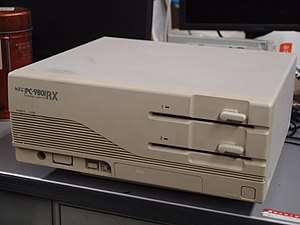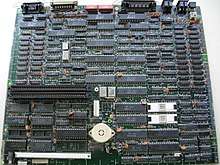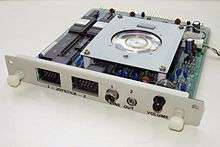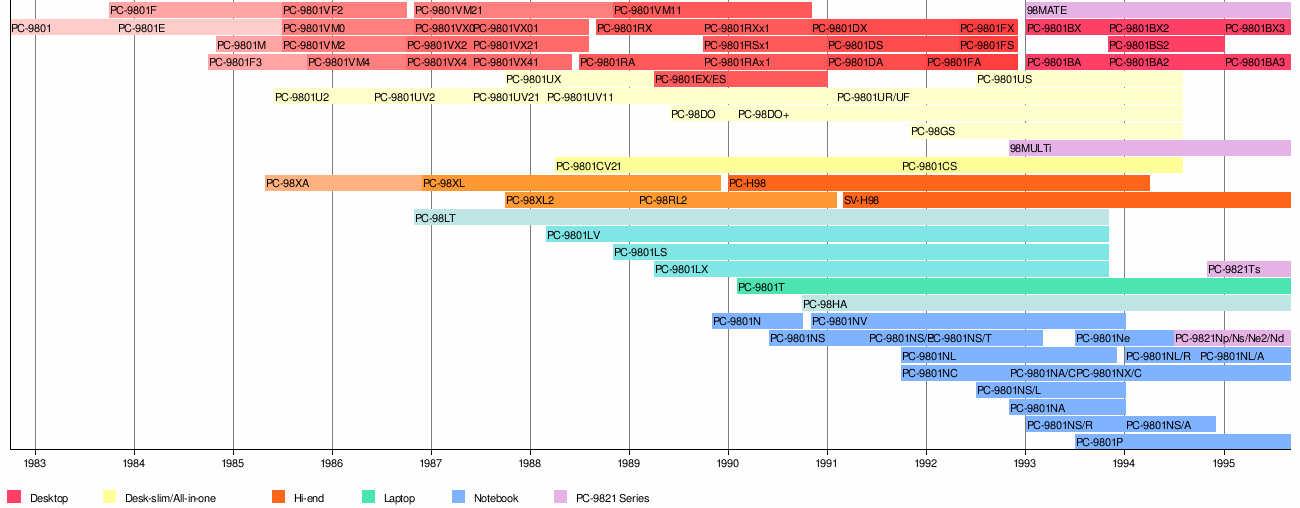PC-9800 series
 PC-9801RX with the Intel 80286 | |
| Type | Personal computer |
|---|---|
| Release date | October 1982 (PC-9801) |
| Introductory price | ¥298,000 |
| Discontinued | 2003[1] |
| Operating system | CP/M-86, MS-DOS, OS/2, Windows |
| CPU | 8086 @ 5 MHz and higher |
| Memory | 128 kilobytes and higher |
| Predecessor | PC-8800 Series |
The PC-9800 series (Japanese: PC-9800シリーズ Hepburn: Pī Sī Kyūsen Happyaku Shirīzu), commonly shortened to PC-98, is a lineup of Japanese 16-bit and 32-bit personal computers manufactured by NEC from 1982 through 2000. The platform established NEC's dominance in the Japanese personal computer market, and by 1999, more than 18 million PC-98 units had been sold.[2]
History

The first model, the PC-9801, was launched on October 1982,[3] and employed an 8086 CPU. It ran at a clock speed of 5 MHz, with two µPD7220 display controllers (one for text, the other for video graphics), and shipped with 128 KB of RAM, expandable to 640 KB. Its 8-color display had a maximum resolution of 640×400 pixels. Its successor, the PC-9801E, which appeared in 1983, employed an 8086-2 CPU, which could selectively run at a speed of either 5 or 8 MHz. The NEC PC-9801VM used NEC V30 CPU.
When the PC-9801 was launched in 1982, it was initially priced at 298,000 yen (about US$1,200 in 1982 dollars).
In the 1980s and early 1990s, NEC dominated the Japan domestic PC market with more than 60% of the PCs sold as PC-9801 or PC-8801. In 1990, IBM Japan introduced the DOS/V operating system which enabled displaying Japanese text on standard IBM PC/AT VGA adapters. After that, the decline of the PC-98 began. The PC-9801's last successor was the Celeron-based PC-9821Ra43 (with a clock frequency of 433 MHz, using a 440FX chipset-based motherboard design from 1998), which appeared in 2000.
While NEC did not market these specific machines in the West, it did sell the NEC APC III, which has similar hardware as early PC-98 models.[4]
Hardware
The PC-98 is different from the IBM PC in many ways; for instance, it uses its own 16-bit C-Bus (Cバス) instead of the ISA bus; BIOS, I/O port addressing, memory management, and graphics output are also different. However, localized MS-DOS or Windows will still run on PC-9801s.
Memory
Many PC-9801 models could increase system memory by expansion boards, daughterboards, or proprietary SIMMs. They were limited to 14.6 MB, due to 24-bit address pins and reserve space. EMS memory boards for C-Bus were also available. The PC-9821Af introduced in 1993 shipped with standard 72-pin SIMMs, broke 14.6 MB barrier and supported memory up to 79.6MB. Later desktop models shipped with standard SIMM or DIMM memory.
Storage
Early PC-9801 models supported 1232 KB 8-inch floppy drives and/or 640 KB 5¼-inch floppy drives. Each used different IRQ lines and I/O ports. Later models supported both interfaces. 5¼-inch and 3½-inch HD floppy disks used the same logical format and data rate with 1232 KB 8-inch floppy disks. They became a non-standard format while formats brought by IBM PC/AT and PS/2 became industrial standard.
The PC-98 supports up to four floppy drives. If the system is booted from a floppy drive, MS-DOS assigns letters to all of the floppy drives before considering hard drives; if booted from a hard drive, it will do the opposite. If the OS was installed on the hard drive, MS-DOS would assign the hard drive as drive "A:" and the floppy as drive "B:"; this would cause incompatibility among Windows PC applications, although it can be resolved with the SETUP command in Windows 9x, turning on the "/AT" switch to assign the Windows system drive to the standard "C:" drive.
The PC-98 used several different interfaces of hard drives. Early models used Shugart Associates System Interface (SASI), and later models used SCSI or IDE drives.
Graphics
A standard PC-98 has two µPD7220 display controllers (a master and a slave) with 12 KB main memory and 256 KB of video RAM respectively. The master display controller handles font ROM, displaying JIS X 0201 (7x13 pixels) and JIS X 0208 (15x16 pixels) characters. Each character had a variety of display options, including bits for secret, blinking, reverse, underline and three intensity bits (grayscale or RGB). The other display controller is set to slave mode and connected to 256 KB of planar video memory, allowing it to display 640 x 400 pixel graphics with 16 colors out of a palette of 4096. The video RAM is divided into pages (2 pages x 4 planes x 32 KB in 640x400 16 colour mode), and the programmer can control which page is written to and which page is output.
Sound

The first generation of PC-9801s, E, F, and M models, only had an internal buzzer. PC-9801U2 and later models could change the sound frequency by controlling the programmable interval timer, like the PC speaker. The PC-8801mkIISR home computer, introduced in 1985, had a Yamaha YM2203 sound chip, a Atari joystick port, and BASIC sound commands. The optional PC-9801-26 sound card was based around these features, although in some PC-9801 models it is integrated with the motherboard. It became the most common sound card for playing in-game music on the PC-98.[5]
It was superseded by the PC-9801-73 (1991) and PC-9801-86 (1993) sound card, which employed the YM2608 and added support for 16-bit stereo sampling. Due to lack of DMA support and poor sound drivers, however, it often had issues in Windows, creating popping and clicking sounds.[6] The PC-9801-118 sound card and later PC-9821 models uses the Crystal Semiconductor's WSS audio codec to resolve this, but the newer sound chip was not compatible the with older conventional sound cards.[7]
Roland released the MPU-401 MIDI interface card for PC-98 computers.
Expansion Bus
All PC-98 desktop models use a 100-pin 16-bit expansion slot. PC-H98 and PC-9821A Series use a proprietary 32-bit Local Bus slot and existing 16-bit slot. The (16-bit) expansion slot were also called C-Bus (Compatible Bus). The PC-9821Xf introduced in 1994 shipped with C-Bus slots and PCI slots on the motherboard, replacing Local Bus.
Clones
Seiko Epson manufactured PC-9801 clones, as well as compatible peripherals.[8]
Software
The PC-98 was primarily used for business in Japan from 1980s to mid-1990s. As of September 1992, out of 16,000 PC-98s in use, 60% were primarily for corporate business software, 10% for operating systems and development tools, 10% for educational software, with the rest being a mix of graphic design, networking, word processing, and games.[9] The Nikkei Personal Computing journal published in 1993 reported that most home users purchased PCs for completing their office work at home. The publisher sent a questionnaire to 2000 readers, and out of 1227 readers who answered, 82% of users were using it for word processing, 72% for spreadsheets, 47% used it as a database, and 43% for games.[10]
One of the PC-98's killer applications, Ichitaro; a Japanese word processor, was released in 1985.[11] It was ported to other machines in 1987. A Japanese version of Lotus 1-2-3 was also ported to PC-98 first in 1986.[12] Ichitaro (all versions) shipped 1 million copies by 1991,[13] and Lotus 1-2-3 a half-million copies.[14]
Software for the PC-98 generally ran from program and data disks (Disk 0 & 1 or A & B). For example, Ichitaro's system disk contained a runtime version of MS-DOS, main programs, an input method editor (ATOK), and its dictionary data file. It used the entire space of a 1.2 MB floppy disk.[11] In 1980s, most machines only had two floppy drives because HDDs were an expensive additional feature for PCs.
The PC9801 had thousands of game titles designed for it, many of which made creative use of the system's limitations (it was originally designed as a business machine) to great commercial success. Despite having hardware specifications far inferior to the Fujitsu FM Towns and Sharp X68000 personal computers, the massive install base and steady flow of game titles (in particular "dōjin" style dating sims and RPGs, as well as early games of Policenauts, YU-NO: A Girl Who Chants Love at the Bound of this World, Koutetsu no Kishi, Mayonaka no Tantei Nightwalker, MechWarrior, Rusty, Hiōden: Mamono-tachi tono Chikai, Shūjin e no Pert-em-Hru, better known as Corpse Party, Slayers, J.B. Harold Murder Club, and Touhou Project kept it as the favored platform for PC game developers in Japan until the rise of the DOS/V clones.
NEC kept much of its hardware and platform proprietary or under license, so while it had a virtual monopoly in the Japanese market, later IBM PC clones with DOS/V and Windows from companies such as Hitachi and Panasonic that did not require such license fees (like Epson's 98 clones) flooded the market and displaced NEC.
Models
Partial list of PC-98 models sold in the Japanese market (no 1992-2000 models, no notebook models, etc.).
| Model | CPU | Year | Features | Other |
|---|---|---|---|---|
| PC-9801 | 8086 5 MHz | 1982 | RAM 128 KB, 6 slot C-bus | 640×400 8 colors, 2 externals floppy drive 8" (optional) 298,000yen |
| PC-9801E | 8086-2 5/8 MHz | 1983 | 2 externals floppy drive 8" (optional) | |
| PC-9801F | 8086-2 5/8 MHz | 1983 | F1 and F2 with 128KB of RAM, F3 256 KB of RAM and hard-disk 10 Mb | Internal floppy drive, 5" 2DD (640KB/720KB) |
| PC-9801M | 8086-2 5/8 MHz[15] | 1984 | M1: 2 internal floppy drive, 5" 2HD (1MB/1.2MB); M2: 1 internal floppy and HD 20Mb | |
| PC-9801VF | NEC V30 8 MHz | 1985 | RAM 256 KB | double 5" floppy-disk 2DD resolution 640×400 with 8 colors (16 colors optional) chosen from among the 4096 available |
| PC-9801VM | NEC V30 10 MHz | 1985 | RAM 384 KB | double 5" floppy-disk 2HD/2DD resolution 640×400 with 8 colors (16 colors optional) chosen from among the 4096 available |
| PC-9801VX | 80286 8-10 MHz | 1986 | RAM 1 MByte | resolution 640×400 with 16 colors chosen from among 4096 |
| PC-9801U | NEC V30 8 MHz | 1985 | 2 floppy-disk 3.5" 2DD | |
| PC-9801UV | NEC V30 10/8 MHz | 1986 | 2 floppy-disk 3.5" 2HD/2DD | |
| PC-9801UX | 80286 10 MHz | 1987 | 2 floppy-disk 3.5" 2HD/2DD | |
| PC-9801RA | 80386DX 16-20 MHz | 1988 | 2 floppy-disk 5" 2HD/2DD | |
| PC-9801RS | 80386SX 16 MHz | 1989 | 2 floppy-disk 5" 2HD/2DD | |
| PC-9801RX | 80286 12 MHz | 1988 | 2 floppy-disk 5" 2HD/2DD | |
| PC-9801ES | 80386SX 16 MHz | 1989 | ES2 no HD, ES5 HD 40MB | 2 floppy-disk 3.5" 2HD/2DD |
| PC-9801EX | 80286 12 MHz | 1989 | 2 floppy-disk 3.5" 2HD/2DD | |
| PC-9801DA,DA/U | 80386DX/20 MHz | 1990 | /U means 3.5" floppy No /U means 5" floppy | |
| PC-9801DS,DS/U | 80386SX/16 MHz | 1990 | /U means 3.5" floppy No /U means 5" floppy | |
| PC-9801DX,DX/U | 80286 12 MHz | 1991 | /U means 3.5" floppy No /U means 5" floppy | |
| PC-9801FA,FA/U | 80486SX/16 MHz | 1992 | F means "File slot", memory proprietary expansion slot | |
| PC-9801FS,FS/U | 80386DX/16 MHz | 1992 | ||
| PC-9801FX,FX/U | 80386SX/16 MHz | 1992 | ||
| PC-9821 | Intel 80386SX | 1992 | RAM 4 MByte, drive CD-ROM | hard disk 40 MByte, resolution 640×480 with 256 colors and SCSI interface, Windows 3.0 pre-installed |
| PC-9821Ce | 80486SX 25 MHz | 1993 | Windows 3.1 pre-installed | |
| PC-9821Ce2,Cs2 | 80486SX 25 MHz (Ce2)/33 MHz (Cs2) | 1994 | ||
| PC-9821Cx | 80486SX 33 MHz | 1994 | MS-DOS 5.2/Windows 3.1 pre-installed | |
| PC-9821Cf | Pentium 60 MHz | 1994 | built-in TV tuner, MS-DOS 5.0/Windows 3.1 pre-installed | |
| PC-9821Cx2 | Pentium 75 MHz | 1995 | CD-ROM 4x drive | hard disk 850 MByte, built-in TV tuner, MS-DOS 6.2/Windows 3.1 pre-installed |
| PC-9821Cx3 (98Multi Canbe) | Pentium 100 MHz | 1995 | include Yamaha DB60XG Daughterboard | Windows 95 pre-installed |
| PC-9821 Valuestar V Series V166-V233 | Pentium MMX 166-233 MHz | 1997 | 8x-20x CD-ROM, 2x CD-R, or DVD-ROM drive, 32 MB of RAM, Matrox Mystique 3D accelerator, Harddisk 3-6 GB, 2x USB ports | Windows 95 OSR2.1 pre-installed |
| PC-9821 Cereb (C166-C233) | Pentium MMX 166-233 MHz | 1997 | 28 inch (in C200 Model) or optional 32 inch BS Hi-Vision TV Monitor, Harddisk 3-4GB, VideoLogic Apocalypse 3D 3D accelerator (in C166 Model), DVD and MPEG-2 Decoder (in C200/V and C233/V Model), built-in TV tuner, 13x CD-ROM or DVD-ROM drive (read CD-ROM at 6x in C200/V Model and 8x in C233/V Model), 32 MB of RAM, 2x USB ports (in C233 Model) | Windows 95 OSR2.1 pre-installed |
| PC-9821Ra43 | Celeron 433 MHz | 2000 | 24x CD-ROM drive, 32 MB of RAM, Harddisk 8GB, | Last computer of series |
Timeline of PC-9801 models

See also
References
- ↑ "PC-9800シリーズ受注終了のお知らせ" [PC-9800 Series Discontinuation Notification] (in Japanese). NEC. Retrieved June 7, 2016.
- ↑ "Computing Japan". Computing Japan. LINC Japan. 54-59: 18. 1999. Retrieved 6 February 2012.
...its venerable PC 9800 series, which has sold more than 18 million units over the years, and is the reason why NEC has been the number one PC vendor in Japan for as long as anyone can remember.
- ↑ John Szczepaniak. "Retro Japanese Computers: Gaming's Final Frontier". Hardcore Gaming 101. p. 2. Retrieved 2011-03-16. Reprinted from "Retro Japanese Computers: Gaming's Final Frontier", Retro Gamer (67), 2009
- ↑ "Old-Computers.com". Archived from the original on April 23, 2011. Retrieved 5 May 2011.
- ↑ "PC-9801めくるめく音源ボードの世界" [The world of sound boards for PC-9801]. 蘇るPC-9801伝説 永久保存版 第2弾 [Coming back the legend of PC-9801 Volume 2] (in Japanese). Ascii. 2007. ISBN 978-4-7561-4883-4.
- ↑ 靖間, 誠. "PC-9801-118 / NEC". Retrieved 2018-05-24.
- ↑ "質問 : PC-9801-118を使ってMS-DOS上でFM音源を鳴らしたい。" [Question: I want to play sound with FM synthesizer on MS-DOS using PC-9801-118.]. NEC PC Information Center ROBO (in Japanese). NEC. Archived from the original on 1997-06-10. Retrieved 2018-05-24.
- ↑ "EPSON PC`s DATABASE TOP PAGE" (in Japanese). Retrieved June 10, 2016.
- ↑ "ソフトウェアにおける優位性はどこまで続くか". Oh! PC (in Japanese). Softbank. 12 (8): 155. 1993-09-15. ISSN 0910-7606.
- ↑ "パソコンユーザー実態調査". 日経パソコン (in Japanese). Nikkei BP: 132–137. 1993-06-21. ISSN 0287-9506.
- 1 2 "「一太郎」が知っているPC-9801シリーズの軌跡" [The history of PC-9801 series traced by Ichitaro]. 蘇るPC-9801伝説 永久保存版 第1弾 [Coming back the legend of PC-9801 Volume 1] (in Japanese). Ascii. 2004. pp. 87–92. ISBN 4-7561-4419-5.
- ↑ Edward Warner (1986-09-08). "Lotus Perseveres to Unveil Japanese Version of 1-2-3". InfoWorld. p. 9. Retrieved 2016-05-02.
- ↑ "一太郎累計出荷本数". マイコン. 電波新聞社. 16 (2): 159. 1992. ISSN 0387-9593.
- ↑ "ロータス、「1-2-3」強化版を発売。". Nikkei Sangyo Shimbun. 1991-07-06. p. 5.
- ↑ "Photo of motherboard of PC-9801M".
Further reading
- Joel West and Jason Dedrick, "Innovation and Control in Standards Architectures: The Rise and Fall of Japan’s PC-98", Information Systems Research, Vol. 11, No. 2, June 2000, pp. 197–216
- Ascii Techwrite (1993). 改訂版 PC-9800シリーズ テクニカルデータブック HARDWARE編 [PC-9800 Series Technical Databook (Hardware, Revised Ed.)]. Ascii. ISBN 4756104568.
- Ascii Techwrite (1992). PC-9800シリーズ テクニカルデータブック BIOS編 [PC-9800 Series Technical Databook (BIOS)]. Ascii. ISBN 475610441X.
- Myers, Steven; Smith, Greg (March 1995). "DOS/V: The Soft(ware) Solution to Hard(ware) Problems". Computing Japan Magazine. Archived from the original on 2017-01-15. Retrieved 2017-01-15.
- Boyd, John (April 1997). "From Chaos to Competition - Japan's PC industry in transformation". Computing Japan Magazine. Archived from the original on 2017-01-16. Retrieved 2017-01-16.
External links
| Wikimedia Commons has media related to PC-9800 series. |
- Intro to NEC PC-9800 World
- PC 9801, the first model of the series
- Info about NEC PC-9801M with uPD8086D-2
- "PC博物館" [PC Museum] (in Japanese). Retrieved June 7, 2016.
- "With98 : PC-98データバンク" [With98 : PC-98 Data Bank] (in Japanese). (unofficial). Retrieved June 7, 2016.
- "モデルナンバー (本体) - PC-9800 - NEC - レトロPC - Retro Computer People" [Model number (computers) - PC-9800 - NEC - Retro PC - Retro Computer People] (in Japanese). Retrieved June 10, 2016.
- "なおちま屋 = 昔のカタログ保存館" [Naochima-ya - Old catalogue museum] (in Japanese). Retrieved June 10, 2016.
- Neko Project II, a PC-98 emulator for Windows and Mac OS X
| Preceded by PC-8800 Series |
NEC Personal Computers | Succeeded by |